Today we will visit the 7th Medieval City of Delhi, which is also called Shahzahanabad. Let's know the brief history of this city.
Shah Jahan:
After Jahangir's death on 28 October 1627, his son, Shah Jahan began reigning on 19 January 1628 and ascended the throne on 14 February 1628. He built his city Shahjahanabad in Delhi, which is now the 7th and last medieval city of Delhi. When Shah Jahan fell ill in September 1657, his eldest son Dara Shikoh succeeded his father as king.Aurangzeb:
When Dara Shikoh, the eldest son of Shah Jahan, ascended the throne, this created enmity between his other 3 brothers. Aurangzeb, the third son, defeated the forces of Dara Shikoh near Agra on May 29, 1658 during the Battle of Samugarh. Aurangzeb ruled from 31 July 1658.Shah Jahan fully recovered from his illness, but Aurangzeb declared him unfit to rule and placed him under house arrest in Agra Fort. On 22 January 1666, Shah Jahan died and was buried in the Taj Mahal. Aurangzeb died on 3 March 1707.
Azam Shah:
Third son of Aurangzeb, Azam Shah, ruled from 14 March 1707 to 20 June 1707.Bahadur Shah:
After Aurangzeb's death, it is said that, the Prince Muazzam (later Emperor Bahadur Shah) requested Guru Gobind Singh, the 10th Guru of Sikhism, to help in the battle of succession to the throne with his brother Azam Shah. Guru Sahib met him at a place, where now is Gurdwara Damdama Shahib is located, and together, they devised their strategy. They watched elephant and bull fights for their entertainment. While Muazzam and the Guru were planning the capture of Agra, Prince Azam arrived at Gwalior on 2 June. On June 8 the two armies met at Jajau. Guruji first sent his regiment commander Kuldeep Singh with an army unit and later entered the field himself. Azam's brave son Bidar Bakht was killed. Yuvraj Azam himself was fatally wounded and died on the battlefield. Muazzam was victorious.Bahadur Shah ascended the throne, and ruled from 19 June 1707 until his death on 27 February 1712.
Emperor Bahadur Shah's son Jahandar Shah ruled from 27 February 1712 to 11 February 1713.
Farrukhsiyar, the nephew of Jahandar Shah, who spent the early years of his rule in Dhaka (now the capital of Bangladesh), the capital of Bengal Subah. He defeated Jahandar Shah and ruled from 11 January 1713 – 28 February 1719.
The later Mughal emperors are - Rafi ud-Darajat (28 February 1719 – 6 June 1719), Shah Jahan II (6 June 1719 – 17 September 1719), Muhammad Shah (27 September 1719 – 26 April 1748), Ahmad Shah Bahadur (29 April 1748 – 2 June 1754), Alamgir II (3 June 1754 – 29 November 1759), Shah Jahan III (10 December 1759 – 10 October 1760), Shah Alam II (10 October 1760 – 31 July 1788), Shah Jahan IV (31 July 1788 – 11 October 1788), Shah Alam II (16 October 1788 – 19 November 1806), Akbar Shah II (19 November 1806 – 28 September 1837).
Bahadur Shah II Zafar:
Bahadur Shah Zafar II, Son of Akbar Shah II and the last Mughal emperor, was reigned from 28 September 1837 to 21 September 1857. He was was captured and exiled to Rangoon. After the Indian Rebellion of 1857, Delhi came under the direct control of the British government in 1857. Zafar died on November 7, 1862. Jafar was buried in Yangon.Today our starting point is Kashmere Gate Metro Station (Interchange station of Red Line, Yellow Line and Violet Line).
Qudsia Bagh
Historical Park
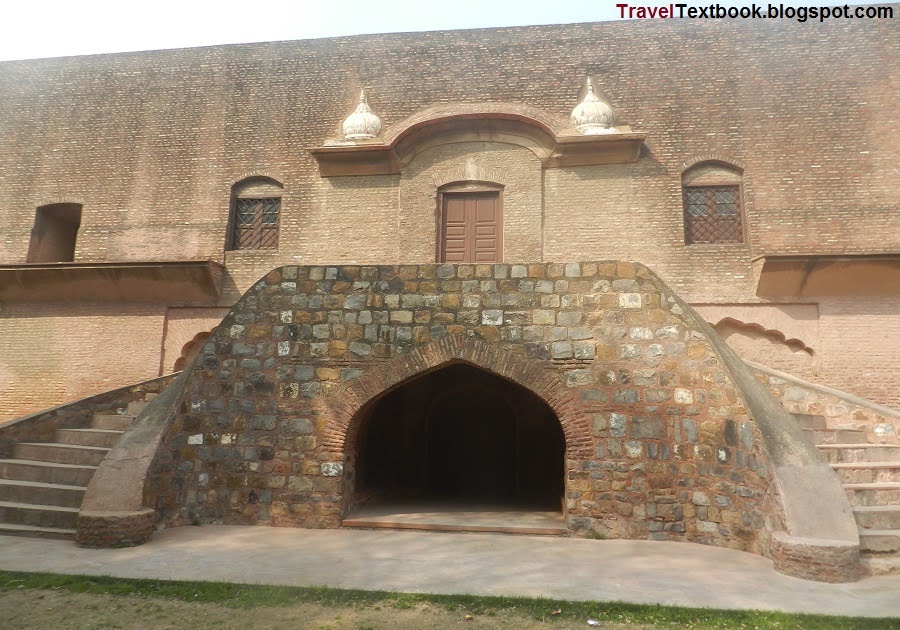
Qudsia Begum (pronunciation: Kursia) was a dancing girl, popularly known as "Udham Bai". She became the 3rd wife of Mughal emperor Muhammad Shah (1719-1748), and mother of Mughal emperor Ahmad Shah (1748-1754).
The complex was constructed in 1748 for Qudsia Begum. Large parts of it were destroyed during the Indian Rebellion of 1857. Today only an entrance gate, the Shahi Mosque and Baradari is remain.
The place has now been turned into a modern park. The main entrance is on the north side. But one can also enter from the west gate or south gate.
That day, I saw that the west gate and the south gate were closed. I walked a few meters east from south gate, and entered through a smaller gate, Gate-4, on the south side. After entering the gate I turned left (west) and went to the horse statue. Local people call it 'Ghora Park' as this horse statue can be seen from the road. Actually it is part of Qudsia Bagh complex.
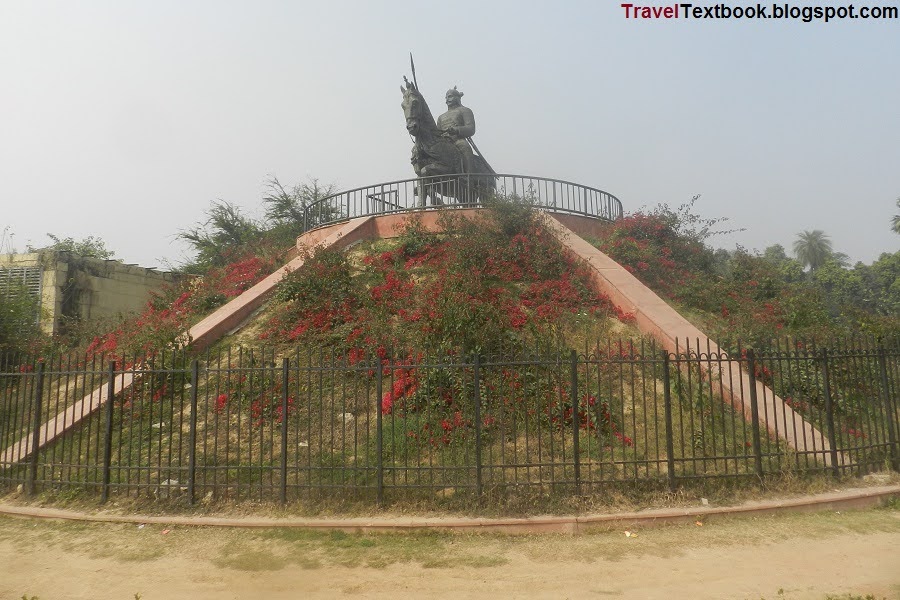
I then went in front of the west gate. I was inside the gate then. An east-west road from the west gate leads straight east to the Qudsia Bagh entrance gate.

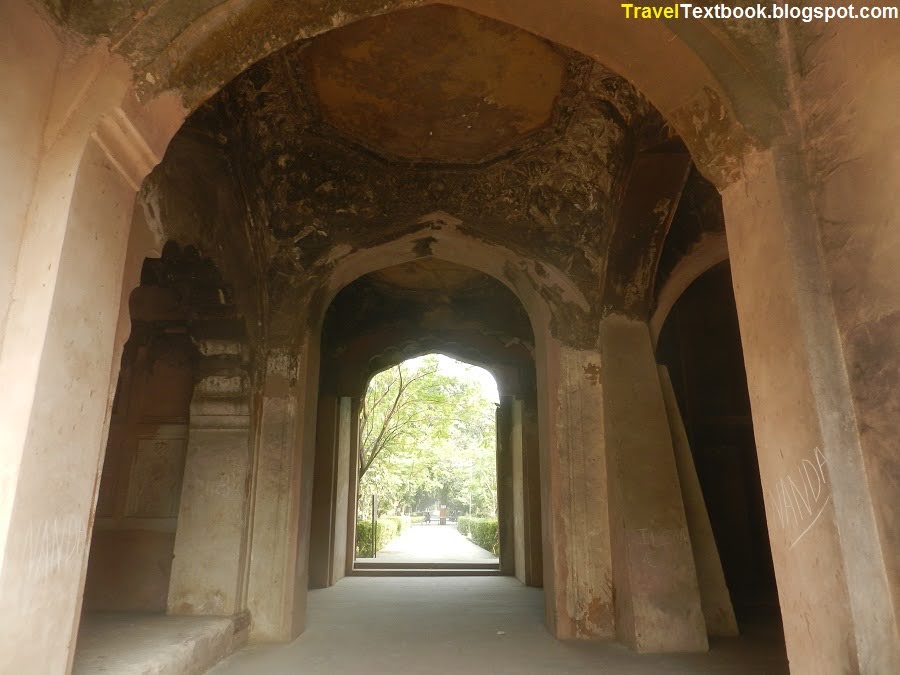
Entering through the gate is a modern park.
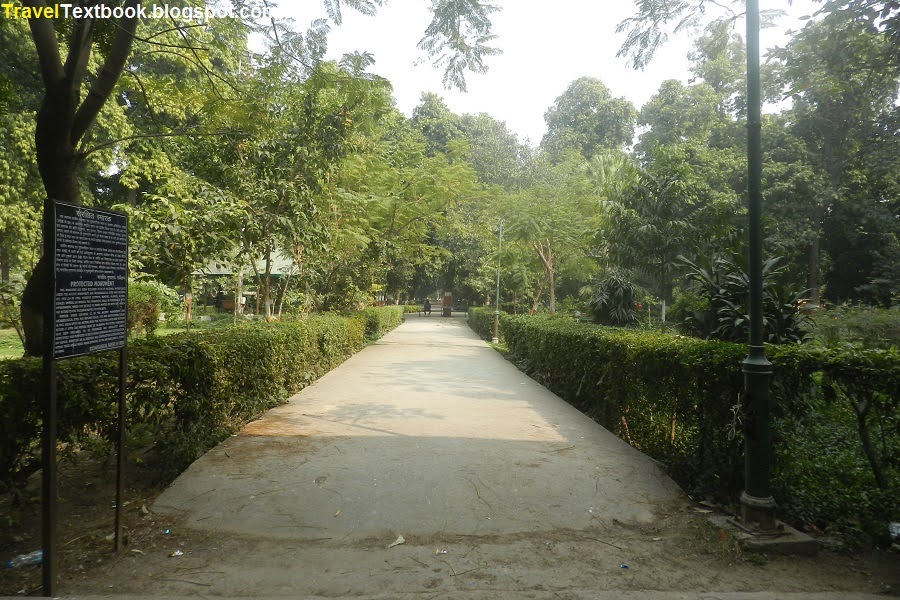

On the right is a children's playground. After the playground a road goes to the right towards a structure.
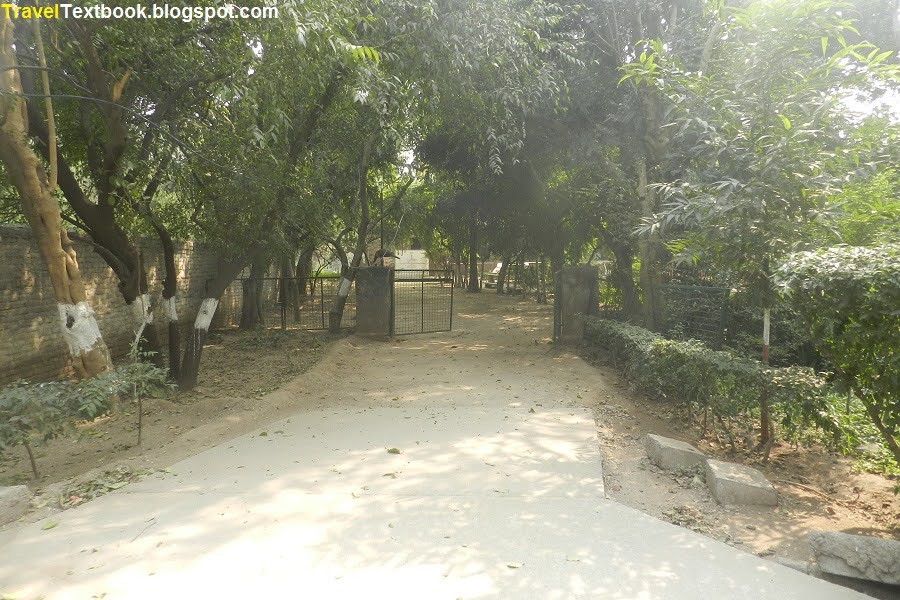
It is said that it was used as a stable during the time of Qudsia Begum, but there is no evidence of this. But it is said that it was the residential bungalow of Mr. Smith, a British officer. The building has been partially repaired on the front side and given a modern look. Exhibitions are held at this place. But there is no show at that time. So it was closed.
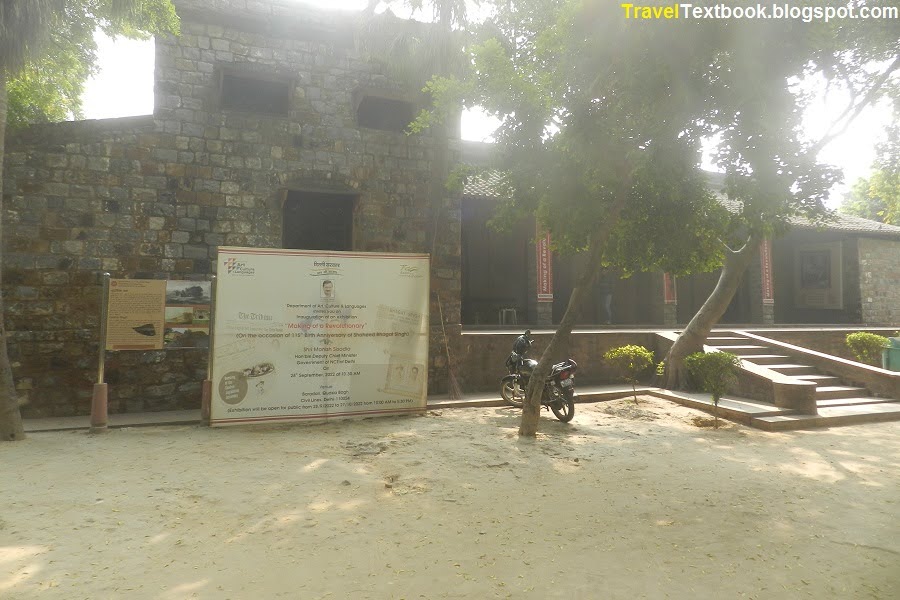
If you go to the back side of it, you can see the original architecture. Original Mughal molding with added British era staircase.

Shahi Masjid is situated at the east end right corner of the park. But getting there from the park is closed.
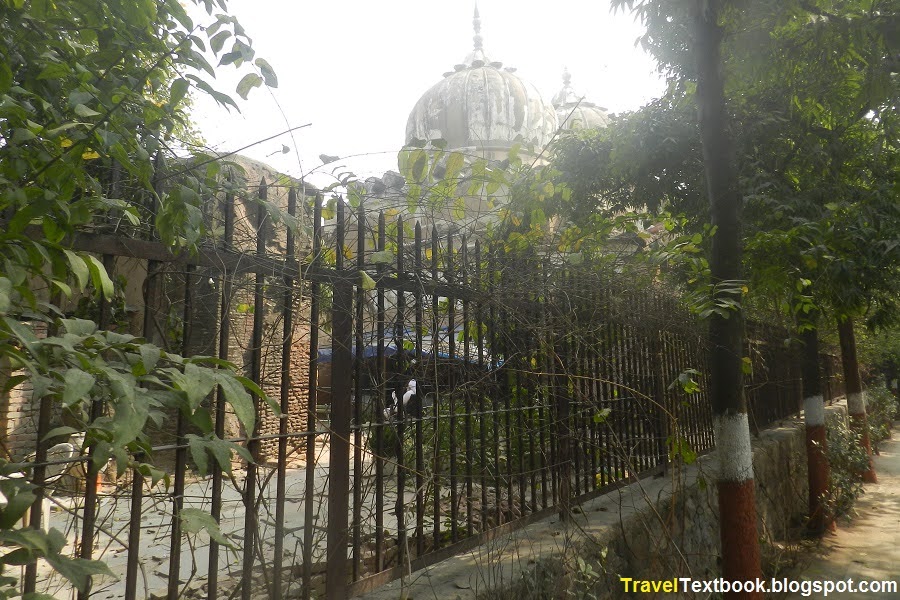
Access is from the east side main road only. So to see Shahi Masjid I again exited through Gate-4 and started walking along the boundary wall towards the eastern end and turned left (north) and walked a few meters to reach Shahi Masjid. Almost destroyed but functioning mosque. People are still praying Namaz. If not take the initiative to rebuild, one day the whole will be destroyed.

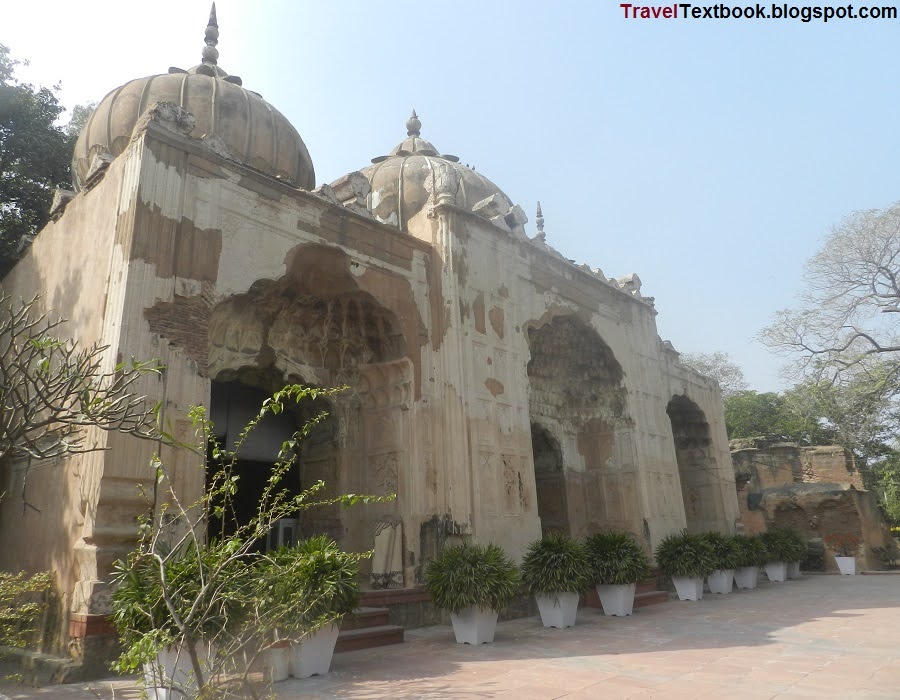
Visiting Time: Sunrise to Sunset.
Entry Fee: Free.
Photography: Photography is allowed.
How to go: The complex is located about 350 meters north of Kashmere Gate Metro Station (Interchange station of Red Line, Yellow Line and Violet Line). There is a bus stop right opposite the Ambedkar museum. I boarded a Kashmere Gate bound bus (blue and green bus), and got down end of the road (west side road of Qudsia Bagh).
Ladakh Buddhist Vihara
Buddhist Temple
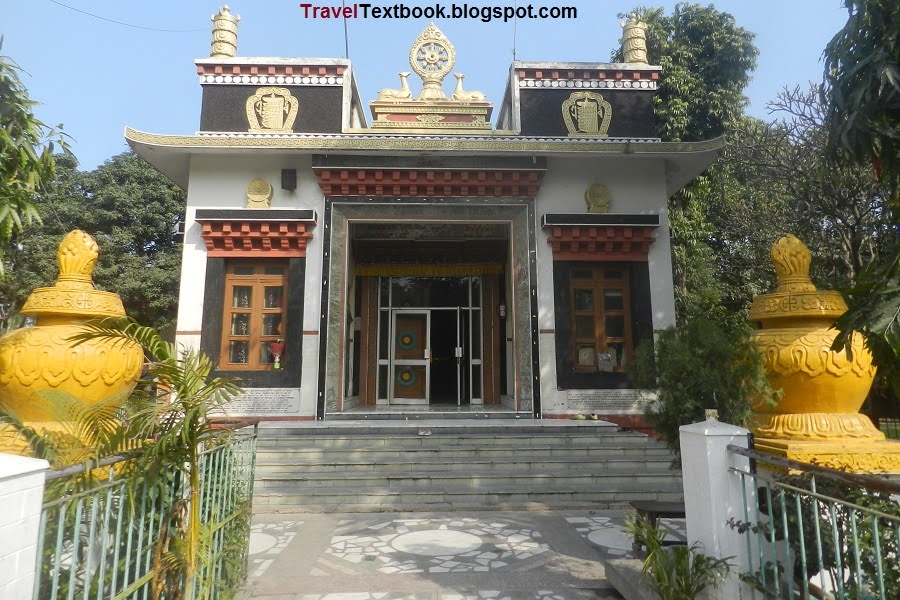
The complex was inaugurated on 24th February, 1963 by Pandit Jawaharlal Nehru, Prime Minister of India with the presence of H H Kushok Bakula, founder and president of vihara.
Entrance to the area through the "Monastery market" gate, under an over-bridge.

When I entered, I saw that there is a walkway on the left side to the Vihara, and straight ahead is a market place with shops on both side of the walkway.

I entered the left side road through a gate to see Bihara.
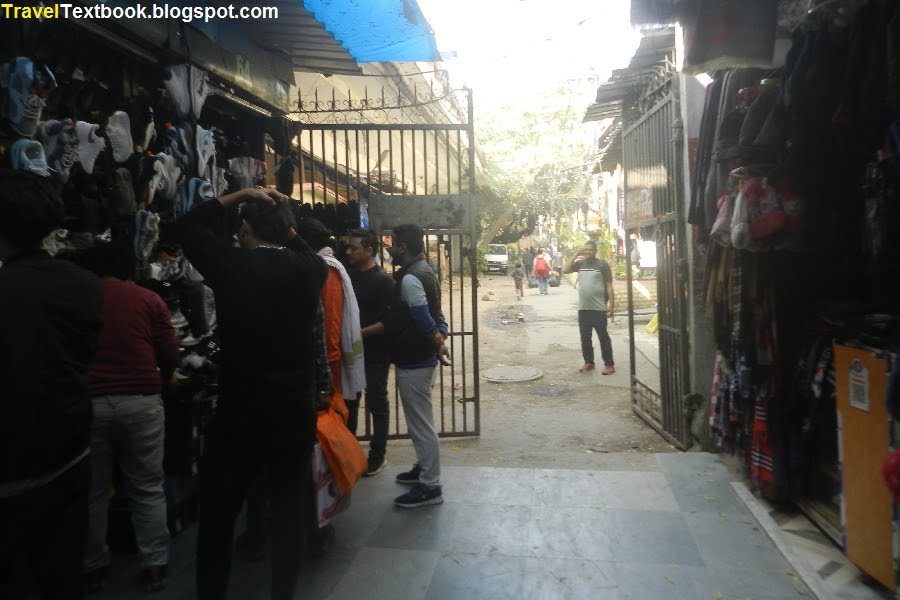
After walking a few meters I saw the monastery on the right. I entered through the gate.
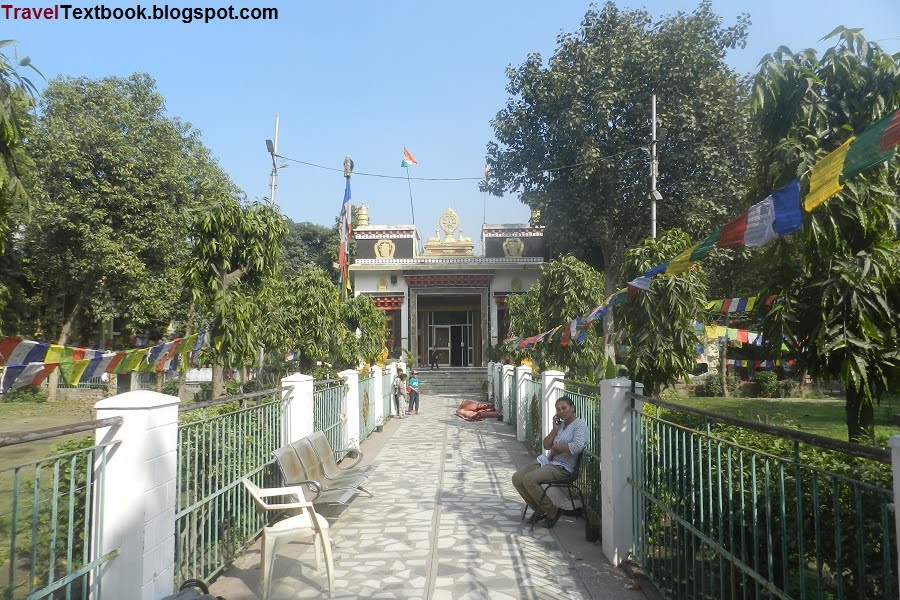
The library cum reading room was built on 30 January 1984 by Kushok Bakula. After a major renovation, the temple was formally opened on 3rd September, 1990 by Kushok Bakula.
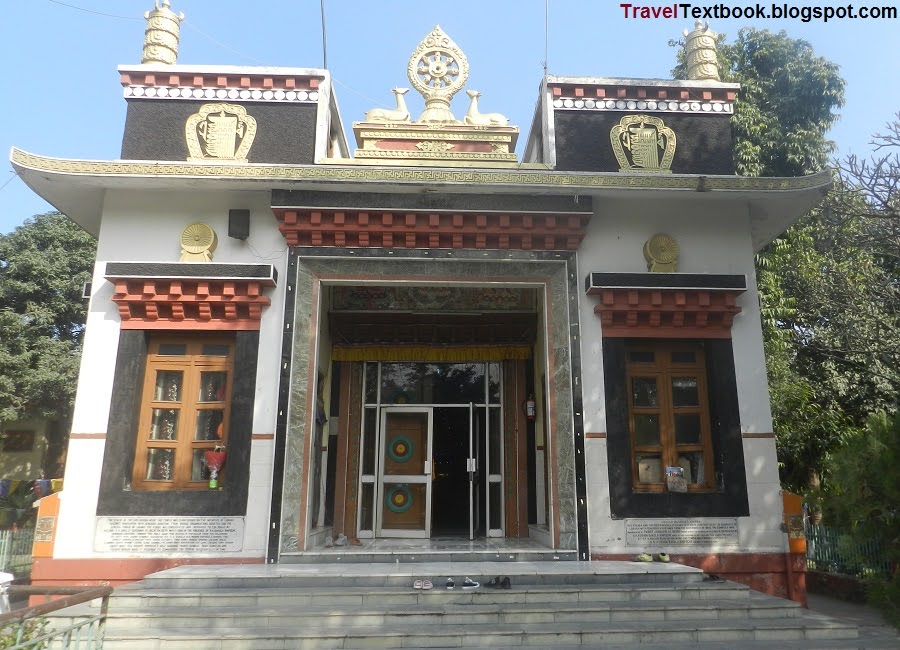
The statue of Lord Buddha inside the temple was commissioned on 13th March 1994.

Then I walked through the market, a single walkway, where you can find a variety of clothes.
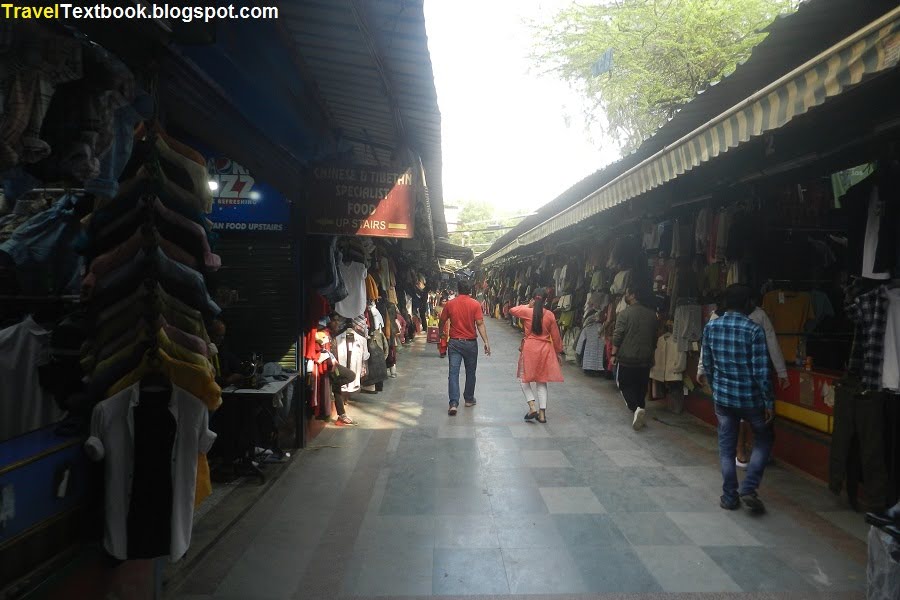
Visiting Time: 6 AM to 9 PM.
Entry Fee: Free.
Photography: Allowed.
How to go: It is located opposite of the road from the northeast corner of Qudsia Bagh. But crossing the busy road is difficult. One has to wait for a long time to cross the dangerous road. You can take risks. But what I did was walk right (south) from Shahi Masjid in Qudsia Bagh, cross the road (it's easy) then walked south to a foot-over bridge. I crossed the road and walked to the left (north). The total distance I walked was 620 meters.
Kashmere Gate
Historical Landmark
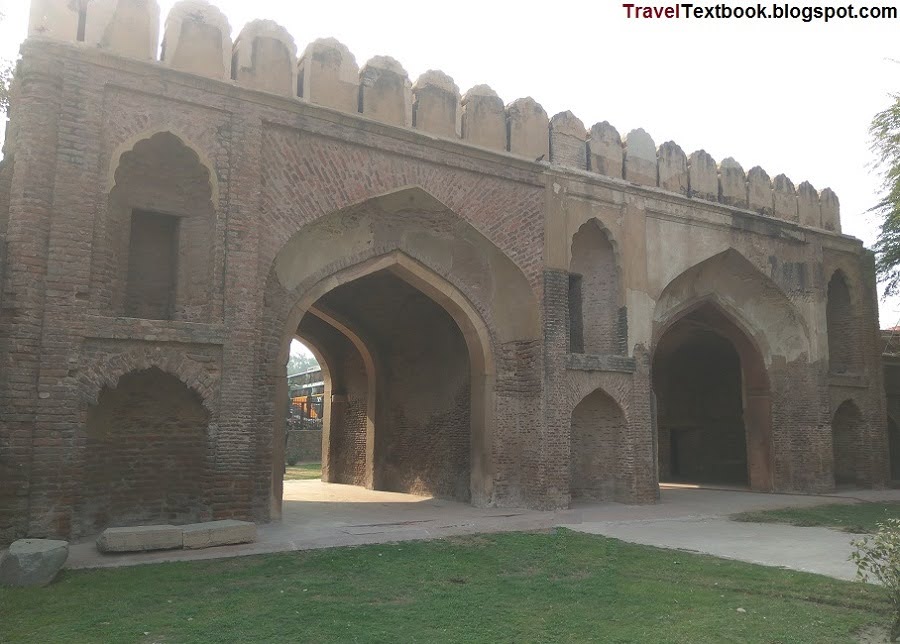
Mughal Emperor Shah Jahan built originally 6 km long wall around Old Delhi, also called Shahjahanabad, built in 1638 AD. There were 14 gates, and 14 smaller wicket gates, called khidkis. Most of them are lost.
Kashmere Gate is the northern gate of the Old Delhi wall. From the North Gate a road led to Kashmir. Hence the gate is known as Kashmere Gate.
When the British first settled in Delhi in 1803, they found the Old Delhi city walls.
In 1965, a section of the Kashmere Gate was demolished to allow for faster movement of vehicular traffic. Since then, it has become a protected monument.

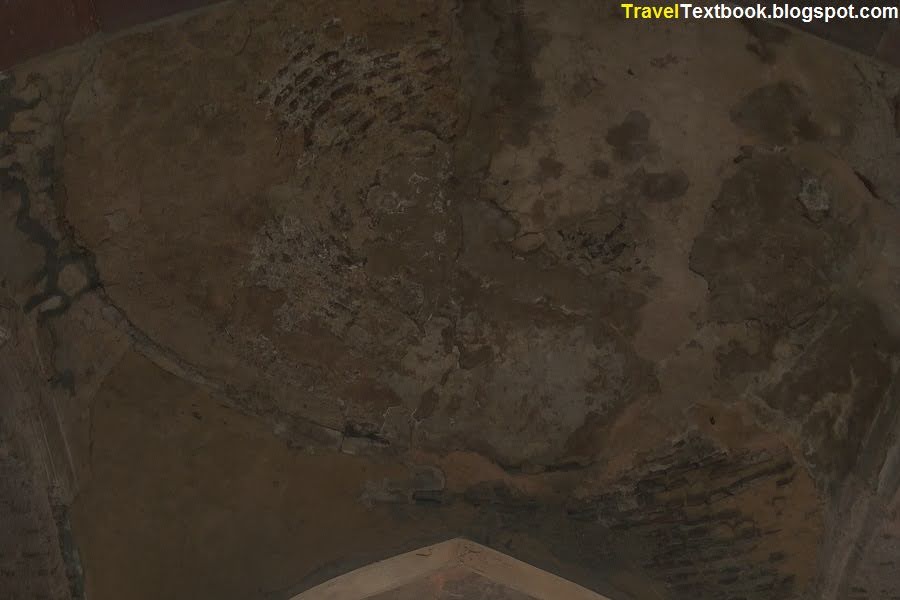

Entry Fee: Free.
Photography: Allowed.
How to go: It is situated about 950 meters south-west from the Ladakh Buddhist Vihara. Exited the Ladakh Tibetan Market and walked to the left (south), until I reached the foot over bridge. I crossed the road over the bridge, but did not go down the stairs. To escape the heat of the sun I went straight to the Maharana Pratap Kashmir Gate bus terminal. Then I exit through west gate of bus stand, and walk towards west, and take left (south) turn below Kashmir gate metro station and walk towards gate-1 on left. After the station Gate-1 is Ritz Cinema Hall (one of the earlier cinema halls, opened here since 1932 as "Capital". It was renamed 'Ritz' in 1942). Crossed the road from Ritz Cinema and reached Kashmere Gate. Kashmere Gate Subway station (Interchange station of Red Line, Yellow Line and Violet Line) is the nearest metro station is located north of the gate. Just exit through gate-1.
St. James Church
Church

The construction started in 1826, and was completed in 1836 by the British Viceroy of India in Delhi. The copper ball and cross on the top were damaged during the 1857 revolt, and were later replaced.
How to go: It is located about 120 meters from Kashmere Gate towards southeast through Lothian Road.
Telegraph Memorial
Memorial
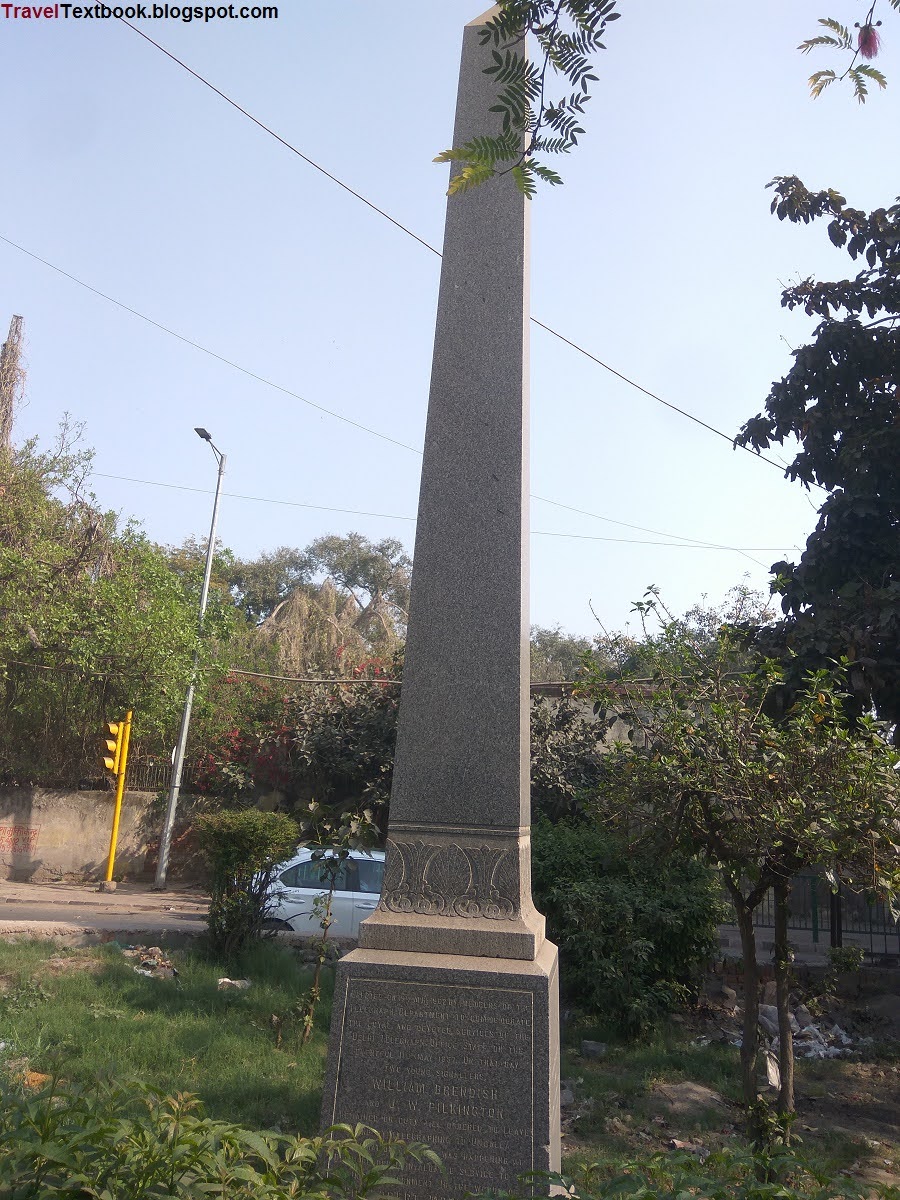
A 20 feet high grey granite obelisk is the Telegraph Memorial was built on 19 April 1902 to commemorate the role this new technology played during the mutiny of 1857.
The Indian Rebellion of 1857 or the First war of Independence was a major uprising in India in 1857–58 against the rule of the British East India Company. Mutiny broke out on 10 May 1857 in the form of mutiny by soldiers of the Company's army in the garrison town of Meerut, northeast of Delhi. The rebellion officially ended on 8 July 1859.
On May 11, 1857, the Uprising began. In order to control the situation and retaliate, quick action was needed. But the only hope was to spread the news quickly and alert other settlements, and the telegraph was the most efficient means back then. J.W. Pilkington and William Brendish, two young British assistant telegraph officers, sat in their cabin near Flagstaff Tower, a signal tower on a nearby ridge, to watch the rebellion unfold around them. They managed to send a message about the "mutiny" to the British military authorities at Ambala, signing at 3 PM with the words "We're off". This message was sent to General George Anson in Simla, and a force was sent from the Punjab to fight the "rebels" in Delhi.
Entry Fee: It is on the road. So no entry fee needed.
Photography: Photography is allowed.
How to go: It is located about 450 meters from St. James Church towards southeast through Lothian Road.
British Magazine Memorial
Memorial

It was the remains of a British magazine, a gunpowder store.
The Indian Rebellion of 1857 or the First war of Independence was a major uprising in India in 1857–58 against the rule of the British East India Company. Mutiny broke out on 10 May 1857 in the form of mutiny by soldiers of the Company's army in the garrison town of Meerut, northeast of Delhi. The rebellion officially ended on 8 July 1859.
The rebellion broke out on 11 May 1857. George Willoughby and nine other officers of the British East India Company defended the magazine until the afternoon. The moment they realized that rebel soldiers had stormed the town, two British officers were charged with two six-pounder guns with light matches loaded with grape shot. They had instructions that the magazine would be blown up if anyone tried to open its gates.
The gates were locked but the soldiers brought ladders to scale the walls. At 3:30 PM, when Willoughby realized that the magazine was in danger of falling into the hands of Indian troops, with no possibility of immediate help from Meerut, he gave the pre-arranged signal to blow it up. The explosion was so loud that it was heard in Meerut which is about 65 km away.
Many soldiers were killed in the blast and many civilians were also killed in nearby houses. Five of the nine British were killed in the blast. Later one was killed by the rebels. All the three survivors went to Meerut. British soldiers and their families sheltered in the flag staff tower on Kamala Nehru Ridge felt the impact of the blast.
Only one gate of the magazine survives. The British placed a plaque on it that read: "This tablet marking the former entrance gate to the magazine is placed here by the government of India". It lists the names of British officers killed by rebels.
Entry Fee: It is on the road. You cannot enter. So no entry fee.
Photography: Photography is allowed from outside.
How to go: It is located about 130 meters from Telegraph Memorial.
Red Fort
Fort
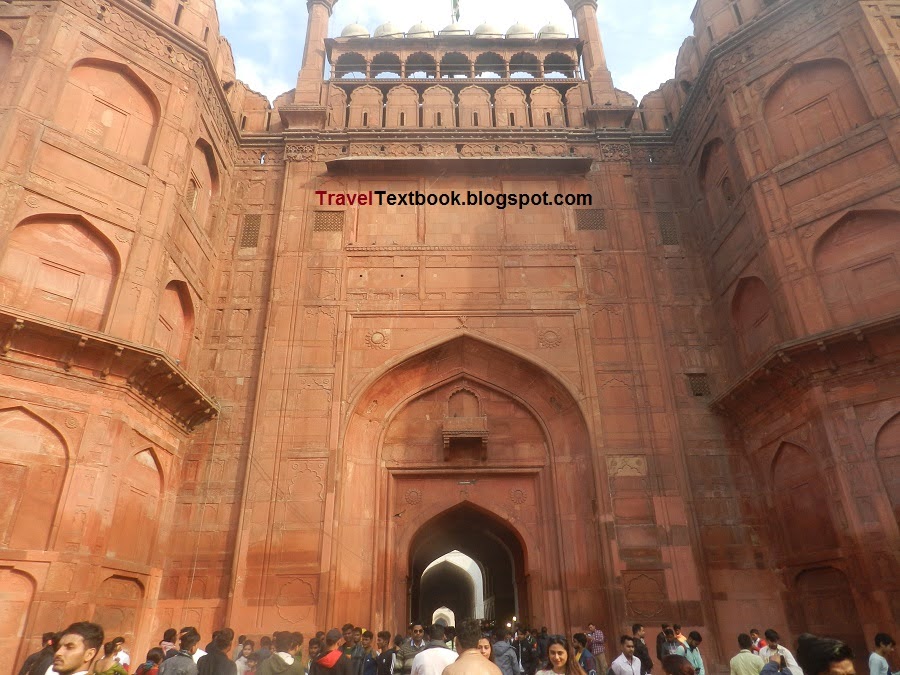
Red fort was constructed by the Mughal Emperor Shah Jahan as his residence palace. Construction began on 13 May 1638 and it was completed on 6 April 1648. It was design by the architect, who also constructed the Taj Mahal.
In 1764, Maharaja Jawahar Singh (son of Maharaja Suraj Mal) attacked Delhi and captured the Red Fort on 5 February 1765. Two days later, after taking tribute from the Mughals, Jawahar Singh removed their armies from the fort. In 1783 Sikh Misl Karor Singhia, led by Baghel Singh, attacked and captured Delhi and Red Fort. After negotiations, Baghel Singh and his forces agreed to leave Delhi and reinstate the Mughal Emperor Shah Alam II. The conditions included the construction of seven Sikh Gurdwaras in Delhi.
After the Second Anglo-Maratha War in 1803, the fort came under the control of the East India Company. The British demolished the Red Fort before ordering its systematic demolition. 80% of the fort's buildings were demolished. The marble buildings on the eastern side of the Imperial Enclosure were escaped complete destruction, but they were damaged. Although the defensive walls and towers were relatively intact, more than two-thirds of the inner structure was demolished. Lord Curzon, the Viceroy of India from 1899 to 1905, ordered repairs to the fort, including rebuilding the walls and restoring the gardens, complete with a water supply system.
In 2007, UNESCO declared it the World Heritage Site.
Inside the Premises:
From the Ticket counter, when you headed to Lahore Gate, you see the barbicans. Shah Jahan's successor, Aurangzeb (reign: July 1658 - 1707), constructed barbicans (In front of the main gate are walls on three sides and a smaller entrance) in front of the two main gates (Lahore Gate and Delhi Gate) to make the entrance to the palace more circuitous.
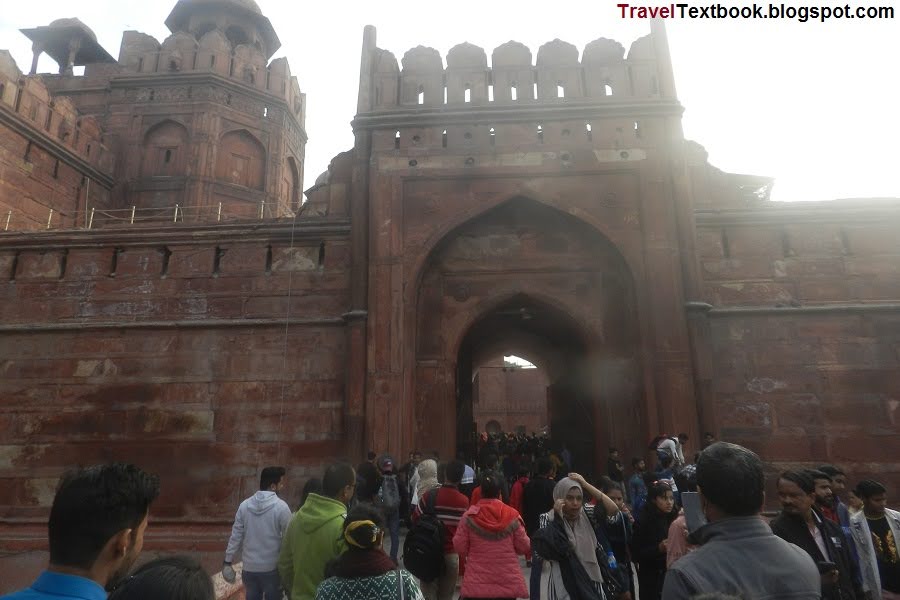
Lahori Gate:

The Lahori Gate is the main gate to the Red Fort. It is located on the western wall of the fort. India's first Prime Minister Jawaharlal Nehru hoisted the Indian national flag over the Lahore Gate on 15 August 1947.
Chhatta Chowk:
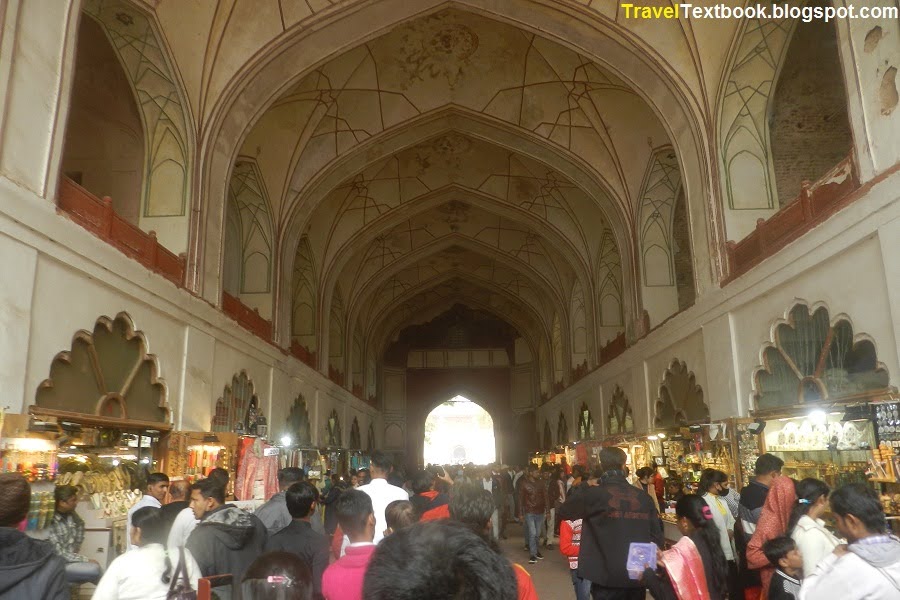
The Chhatta Chowk is a long passage way after the Lahori Gate towards east that contains market. It is lined with two-story flats that contain 32 arched. During the reign of Shah Jahan, Chhatta Chowk was used for trading goods like silk, brocade, velvet, gold, silverware, jewellery, gems and stones.
Museum:

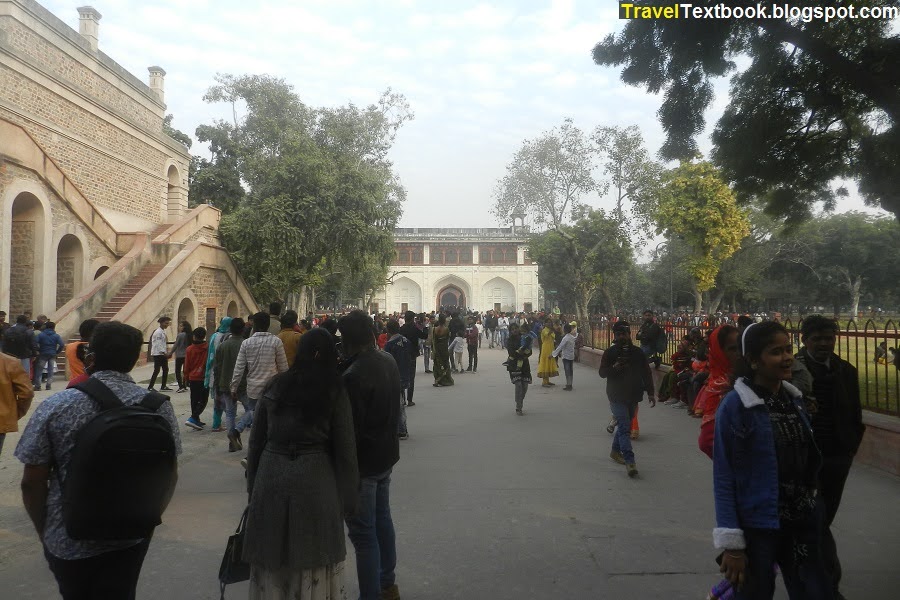
After crossing Chhatta Chowk, you will see Naubat Khana straight ahead, after a Outer Court (Free space west of Naubat Khana), and a building on the left before the outer court. Which was later added during the British period. It is now a museum. To the left of this museum there are 2 more buildings of British era.
Delhi Gate:
It is located on the southern wall of the fort. From the museum, go straight to the south end.
Facing inside Delhi Gate, turn left (East), and walk. Turn left (north) again and walk. You can see 3 buildings added later during the British period. From the 3rd building, turn left (west) and walk. Then turn right (north) and head back south to the museum. Then walk right (east) towards Naubat Khana.
Naubat Khana (Waiting Hall)

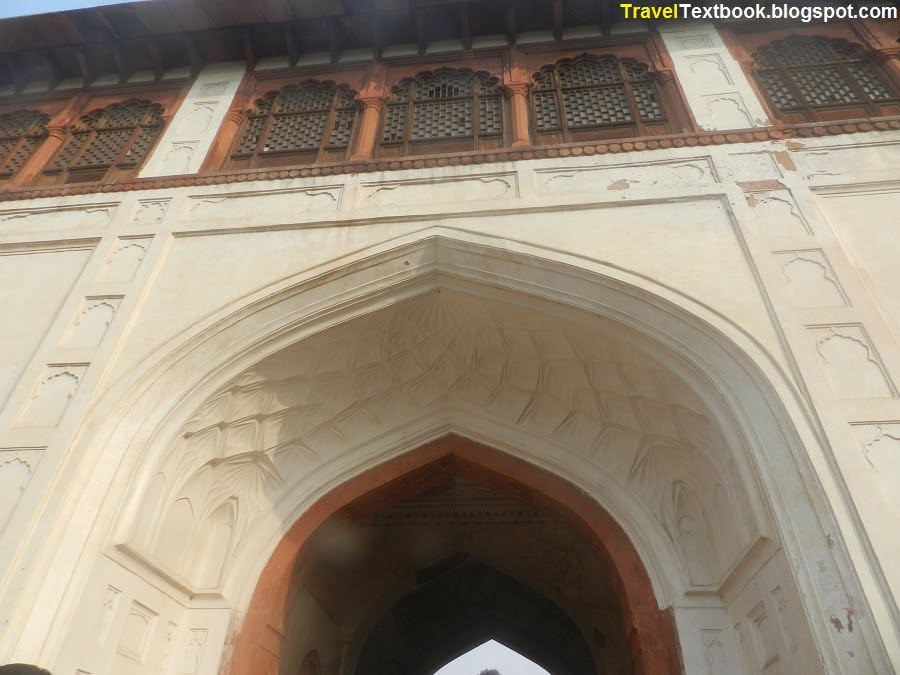
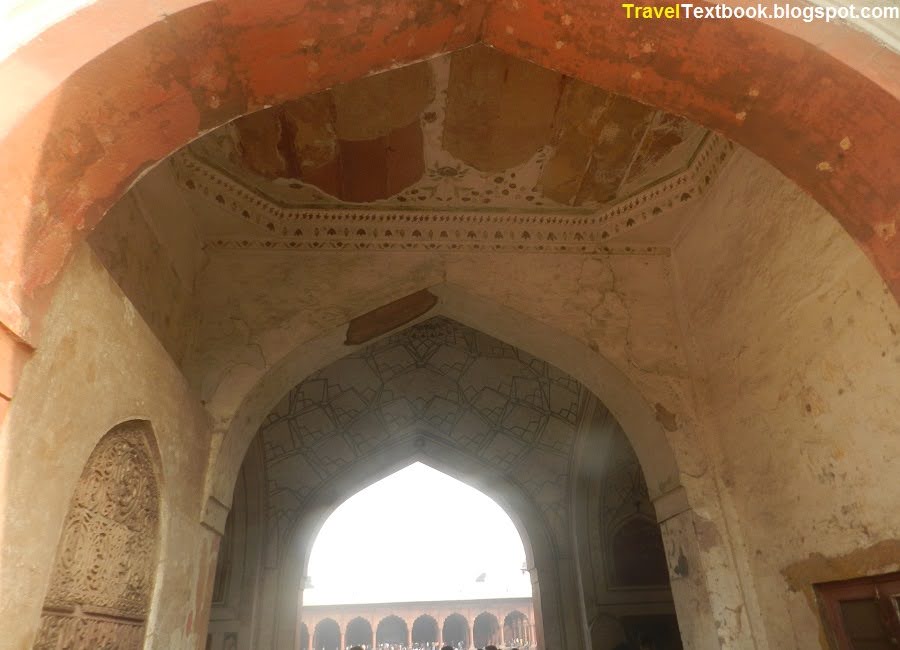
It is located at the entrance between the Outer Court (free space west of Naubat Khana) and Inner Court (free space east of Naubat Khana). It also known as Nakkar Khana (drum house). Music was played daily, at a fixed time, and everyone except royalty had to dismount. An archway (540 x 360 feet) was terminated in the middle of the outer courtyard from the eastern side of the Naubat Khana. Both the north and south sides of the Naubat Khana were connected by archway. After the Mutiny of 1857 the archways and the central tanks were demolished by the British. Mughal kings Jahandar Shah (1712-13) and Farrukhsiyar (1713-19) are said to have been assassinated here. The Indian War Memorial Museum is located on the second floor.
Diwan-i-Aam (Hall of Audience)

The Diwan-i-Am (Hall of Audience) is situated to the east of the outer court, where the Mughal Emperor Shah Jahan (1592–1666) and his successors received the general public and heard their complaints.
The hall is 100 ft x 60 ft in size and open on three sides and a few rooms on the east side.

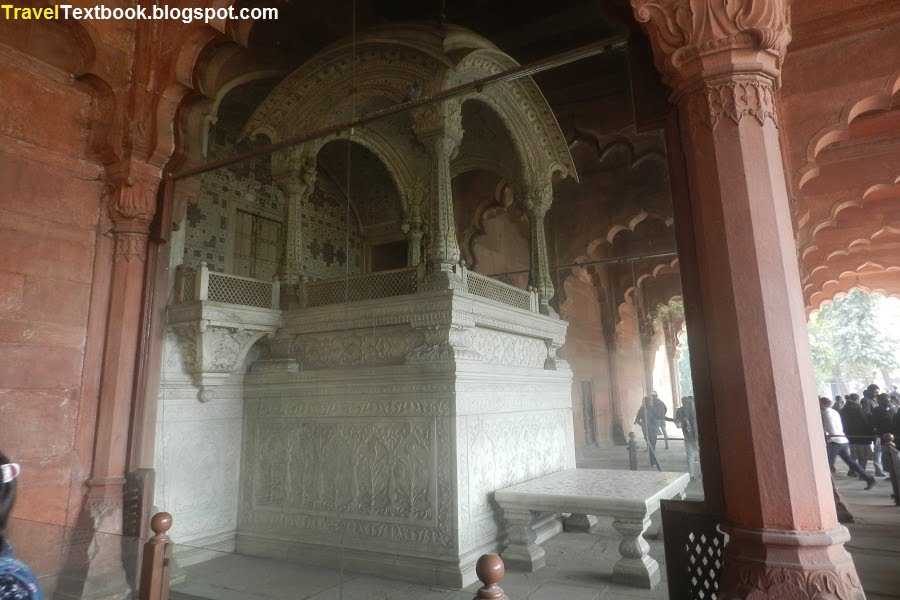
In the middle of the eastern wall is a throne, which was used by Shah Jahan, and later his successors. A marble desk, in front of the throne, was used by the prime minister to receive petitions.
The hall was later restored by Lord Curzon.
The main six buildings east of Diwan-i-Am, are aligned from north to south along the eastern edge of the fort. All six palaces were connected by a canel, known as the Nahr-i-Bihisht ("Stream of Heaven"), running through the center of each palace. Water is drawn from the Yamuna through a tower called "Shah Burj" at the north-east corner of the fort.
Rang Mahal:
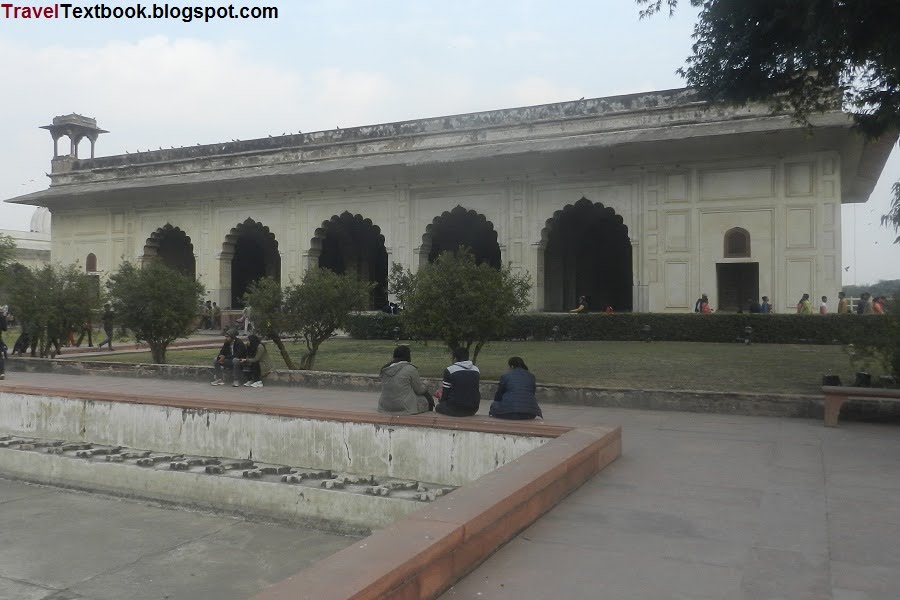
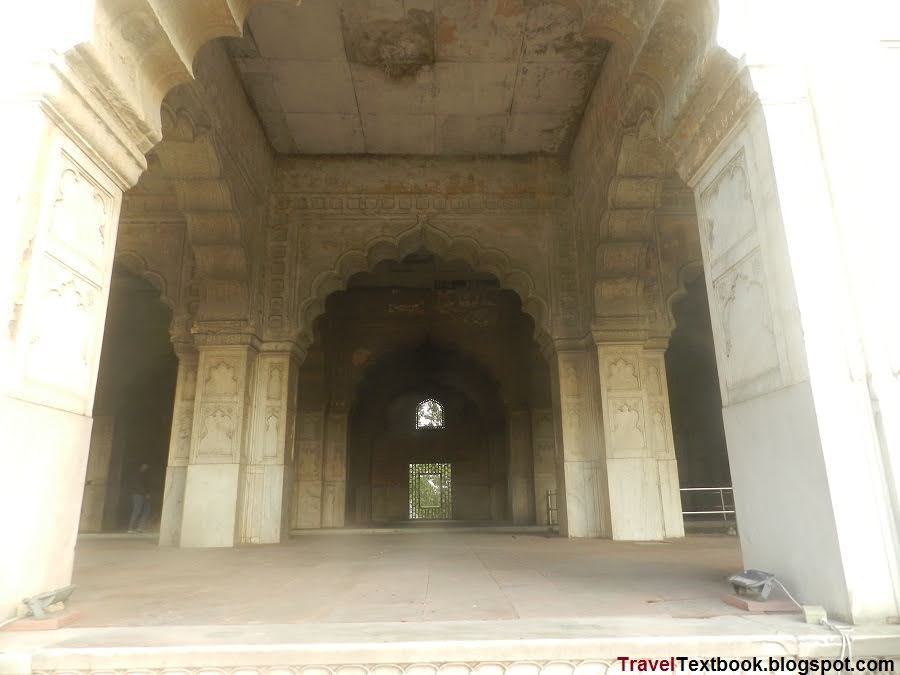
It is situated at the eastern end from Diwan-i-Am. A pool is situated between Rang Mahal and Diwan-e-Am. Rang Mahal means palace of colors. It was known as "Imtiaz Mahal" during the reign of Shah Jahan. Here the female members of the royal family could rest. The interior of the building was once richly painted and decorated. Some of the apartments in this building are called Sheesh Mahal because of the small mirror pieces that cover the ceiling.
Through the center of the palace, a shallow canal called "Nahr-e-Behest" flowed into a marble basin carved into the floor. Below the Rang Mahal was a tehkhana (basement), which was used by women on hot days.
After the British captured the fort in 1857, Rang Mahal was briefly used as a mess hall.
Mumtaz Mahal:
Mumtaz Mahal is located to the south of Rang Mahal. Just north of the Mumtaz Mahal was a small meeting room (Chhoti Baithak) which no longer exists. Mumtaz Mahal was built for Arjumand Banu Begum (Mumtaz), wife of Mughal Emperor Shah Jahan.
It consists of six apartments divided by arched pillars and was originally painted with floral decorations on the interior. Mumtaz Mahal was part of the zenanas (women's quarters - Rang Mahal and Mumtaz Mahal).
After the British captured the fort, it was used as a prison camp.
The building currently houses an exhibit of the Red Fort Archaeological Museum.
Khas Mahal (Emperor Palace):
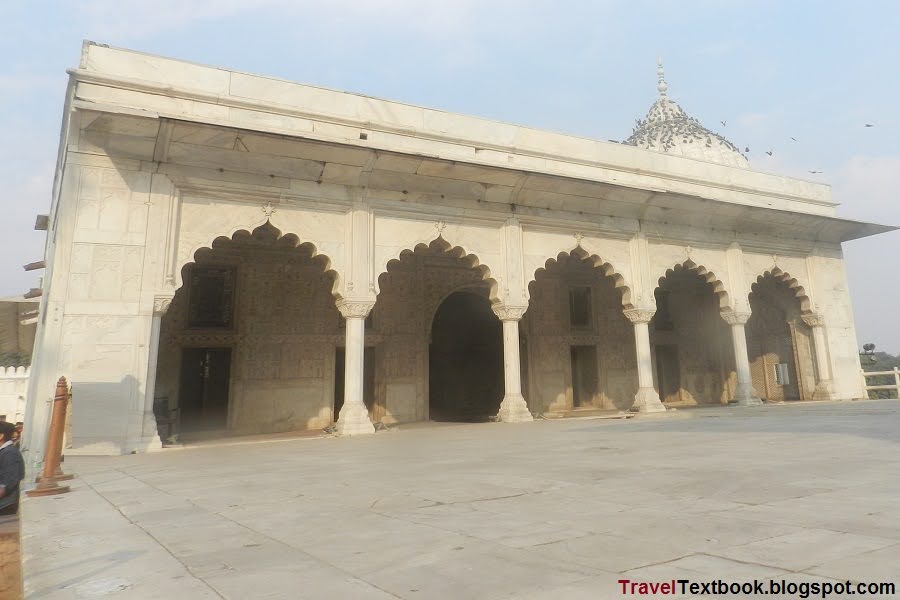

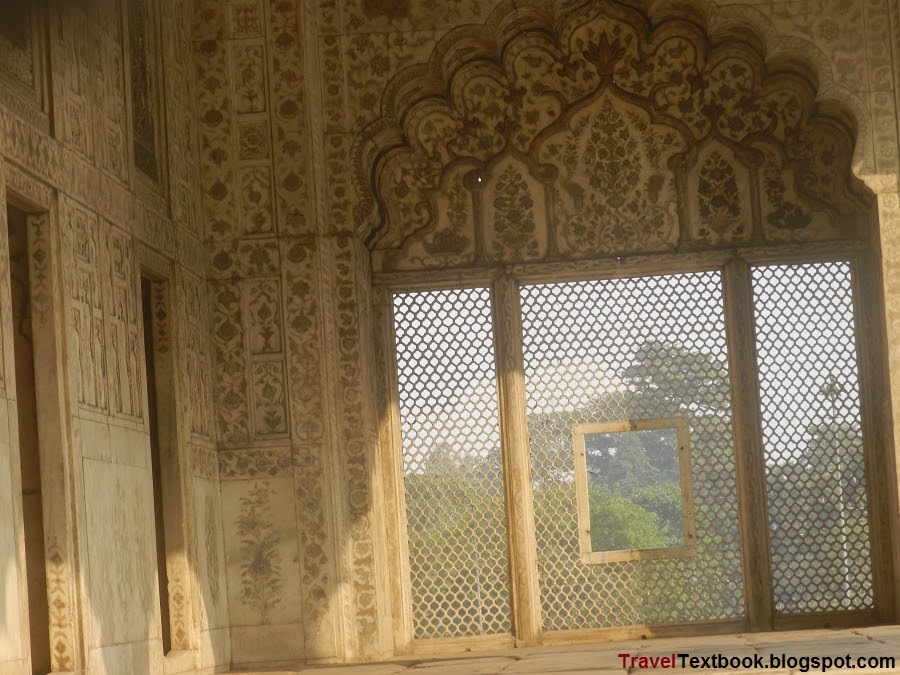
The Khas Mahal is located north of Rang Mahal. Khas Mahal served as the personal residence of the Mughal Emperor.
It consists of three parts: Viz-tasbih-khana (chamber of telling beads), khwabgah (sleeping room), and tosha-khana (wardrobe) or baithak (sitting room).
The tower on the eastern side of the Khas Mahal is a semi-octagonal tower called "Muthamman Burj". A balcony was constructed on the central side of the tower by Akbar II in 1808-09 CE. Where every morning the Mughal emperor appeared before his subjects. This event was known as "Jharokha Darshan".
It was from this balcony that King George V and Queen Mary appeared before the public during the Delhi Durbar in 1911.
Diwan-i-Khas (Hall of Private Audience):
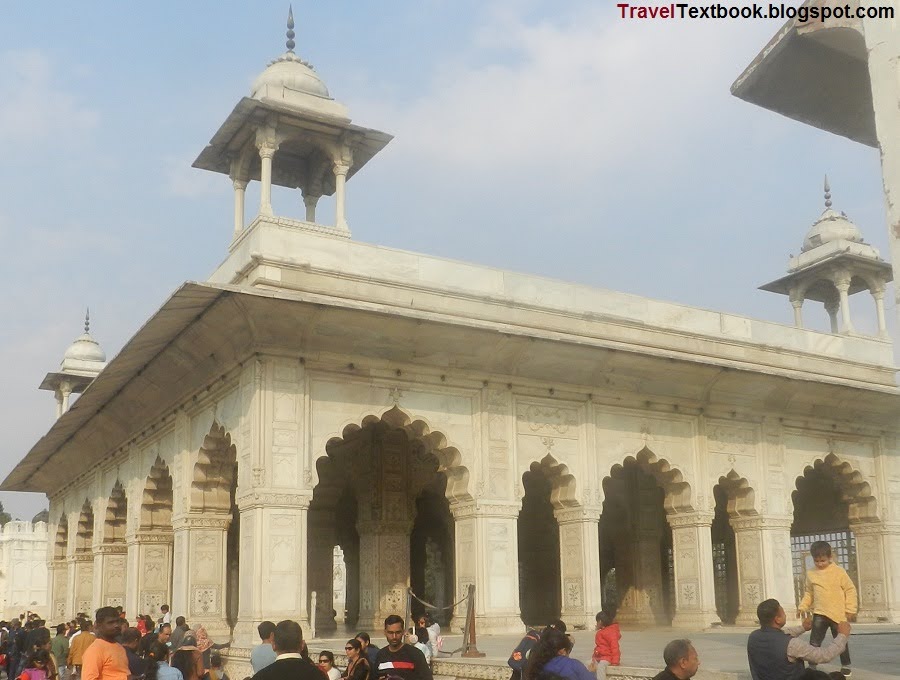
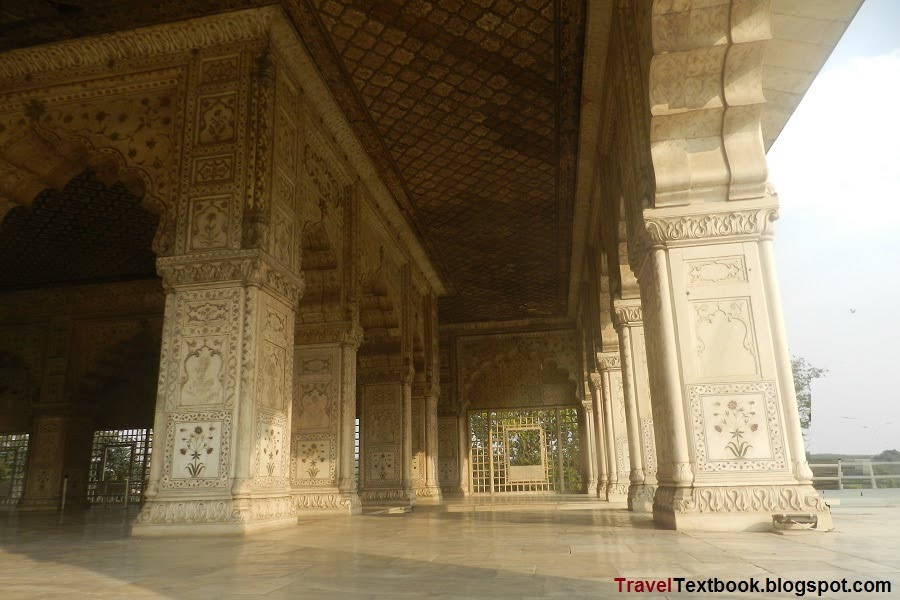

It was built as a venue for receptions. It is the place where the Mughal Emperor Shah Jahan received courtiers and state guests. It was also known as Shah Mahal.
A gate on the northern side of the earlier Diwan-i-Aam led to the inner court of the palace called "Jalau Khana" and "Diwan-i-Khas". Originally there were two enclosures to the west of the hall, one for the higher ranks and the other for the lower ranks. These arcaded courts were destroyed after the Indian Mutiny of 1857.
The current ceiling was installed in 1911.
Hammam (Imperial Bath):

It is located in the north of the Diwan-i-Khas. It consists of three rooms separated by corridors and crowned by domes. The rooms are lit by colored glass skylight. Two rooms on either side of the present entrance are believed to have been used by royal children for bathing. The eastern apartment with three fountain basins was originally used as a dressing room. Each room had a fountain in the center and one room had a marble pool. It is said that perfumed rose water once flowed from the tap. The west apartment was used for hot or steam baths and had heating on its west wall.
Moti Masjid (Mosque):
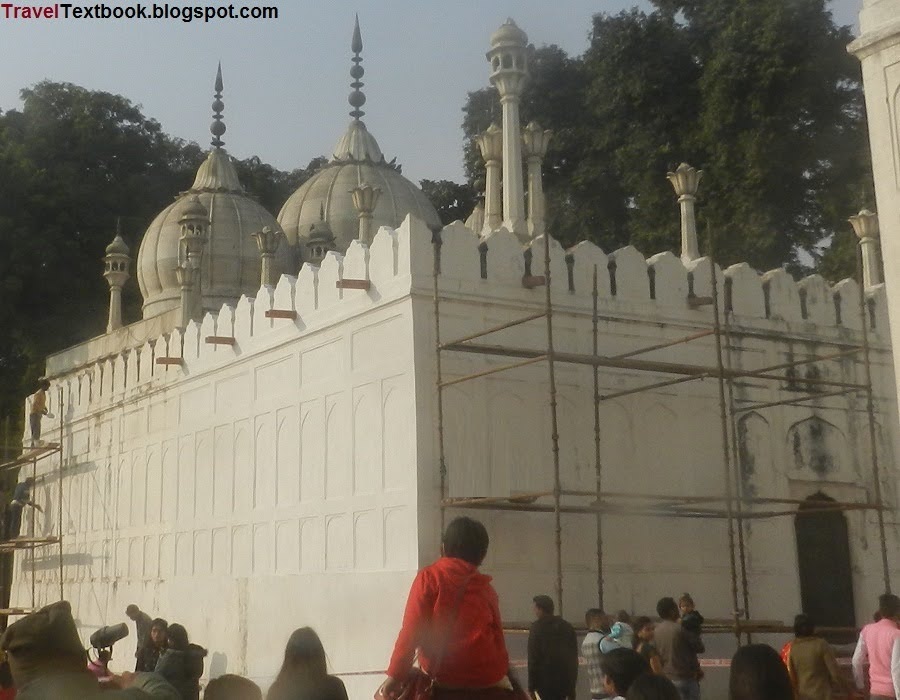
The mosque was built by Mughal Emperor Aurangzeb for his second wife Nawab Bai from 1659-1660. The mosque was also used by women of the zenana. The prayer hall has three arches and is divided into two aisles. It is topped by three domes.
Hira Mahal (Pavilion):

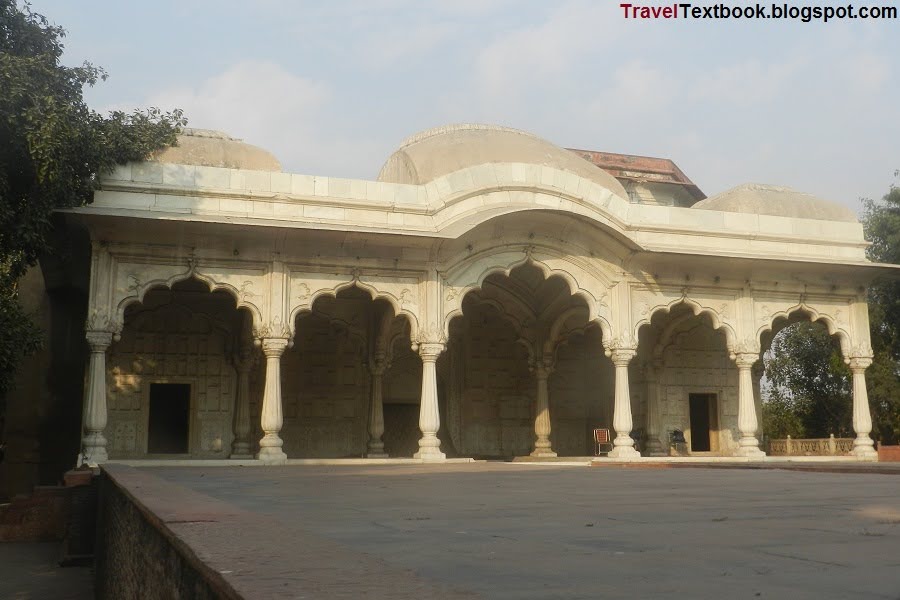
This white marble pavilion was built in 1842 during the reign of Bahadur Shah II. It is located a few meters north of the hammam.
Shah Burj (Water Tank):

It is located northeast corner of Red Fort. Water is brought from the Yamuna River to this "Shah Burj" and supplied to the "Nahr-e-Bihisht" ("Stream of Heaven").
Dawat-i Khana:
It is located west of Shan Burj. Also called Princes Quarter. A quarter of the royal princes date back to the late Mughal Empire. Its structure has changed over time, and losing its original appearance. It was built for princes and served as a residence for many members of the Mughal royal family.
After the Indian Mutiny of 1857, the occupying British forces converted the palace into a meeting and entertainment hall and named it "Tea House". The palace is open to visitors as a tea house and tourist shop.
Bhadan Pavilion:


It is located straight west of Shan Burj.
Hayat Bakhsh Bagh (Garden):
The Hayat Baksh Bagh, which means "Life-bestowing garden", was built by Mughal Emperor Shah Jahan. The garden is located from Bhadan Pavilion to South Sawan Pavilion. The Hayat Bakhsh Bagh features a reservoir, which is now dry, and channels through which the Nahr-i-Bihist flows. At each end is a white marble pavilion, called the Sawan and Bhadon Pavilions. Zafar Mahal is located in the center.
Zafar Mahal:

The structure was built in 1842 during the reign of Bahadur Shah II and named after him. This pavilion stands in the middle of a pre-existing water tank. Originally a red sandstone bridge led to the pavilion, which was probably lost after the Indian Mutiny of 1857. After the occupation in 1857, British soldiers used the tank for a while as a swimming pool.
Sawan Pavilion:
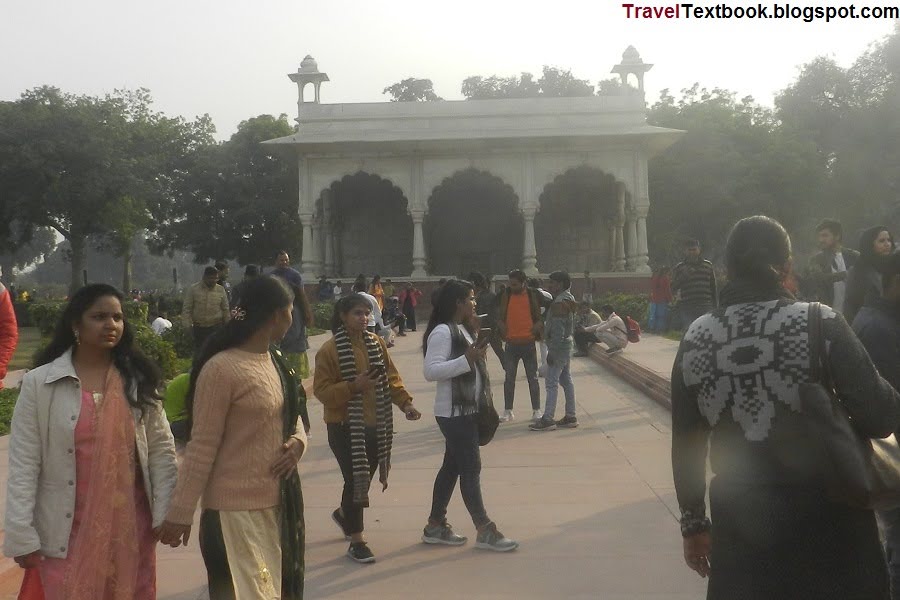
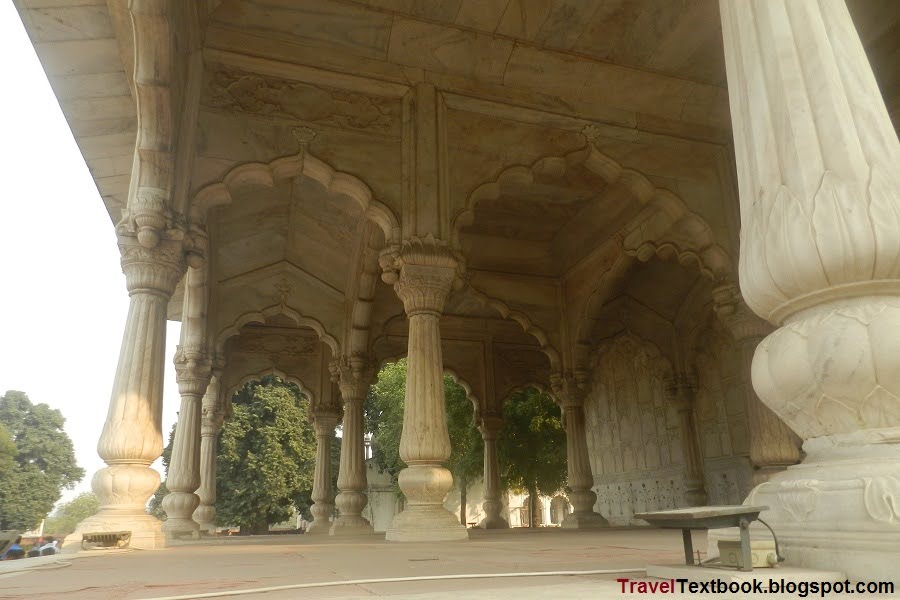
It is located south of Zafar Mahal and south end of Hayat Bakhsh Bagh.
Mehtab Bagh:
To the west of Hayat Bakhsh Bagh was another garden called Mehtab Bagh or "Garden of the Moon". After the failed revolt, the British completely destroyed this garden and built four large military barracks in its place.
Go west from Sawan Pavilion. Public toilet located at the straight end. A British barrack on the left side and 3 British barracks on the right side. From the north.
Baoli (Step-well): Baoli is uniquely designed with two staircases leading to the well.
It was not demolished by the British after the Indian Mutiny of 1857. The rooms inside the baoli were converted into prisons. During the Indian National Army trials in 1945-46, it housed Indian National Army officers.
A road leads west from the 2nd barracks from the north. You will see Baoli there.
Entry Fee: 50 Rupees (US$ 0.60) for Indian without museum. 80 Rupees (US$ 0.97) for Indian with museum. 600 Rupees (US$ 7.26) for foreigner without museum. 950 Rupees (US$ 11.49) for foreigner with museum
Show: Light and sound show held in Hindi and English at 6 PM. Entry fee around 80 Rupees (US$ 0.97).
Photography: Photography is allowed.
How to go: It is located about 750 meters from British Magazine Memorial towards south. Just east side of Lal Quila Subway station (interchange of Violet Line, Yellow Line and Red Line) gate-4,
Salimgarh Fort
Fort
Salimgarh Fort was built in 1546 by Salim Shah Suri, son of Sher Shah Suri on the bank of Yamuna River.During the British rule, the Indian Rebellion of 1857, was conducted from this fort by Emperor Bahadur Shah II. In August and early September 1857 he held meetings at the fort on war strategy. In mid-September 1857, British troops entered the fort. After suppressing the rebellion, the fort was used as an army camp by the British for some time.
Since 1945, used as a penitentiary to house prisoners from the Indian National Army (INA). The Army transferred the fort to ASI's possession in December 2003.
Entry Fee: It is inside the Red Fort. So free with Red Fort entry.
How to go: It is accessible through the inside of Red Fort.
Aah.. I just finished my journey today. The nearest metro station is "Lal Quila Subway Station" (Violet Line), just west side of Red Fort. Now it's time to go back to my accommodation.
Hope this post will help you. Write your comment below and please share it with your friends.
You May Also Like
Travel Delhi: Day-1
Travel Delhi: Day-2
Travel Delhi: Day-3
Travel Delhi: Day-4
Travel Delhi: Day-5
Travel Delhi: Day-6
Travel Delhi: Day-7
Travel Delhi: Day-8
Travel Delhi: Day-9 (You are here)
Travel Delhi: Day-10
Travel Delhi: Day-11
Travel Delhi: Day-12
Travel Delhi: Day-13
Travel Delhi: Day-14
Travel Delhi: Day-15
Travel Delhi: Day-16
Travel Delhi: Miscellaneous
Click below to go


No comments:
Post a Comment